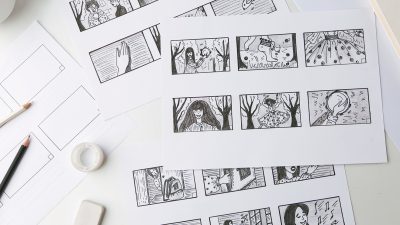The specific location where you film your next project is of utmost importance to the final product. Your chosen space will impact everything from the screenplay, to the audio and visual setup of your shoot. Here are the key environmental elements you need to be aware of. We’ve also and ways to adapt to them to ensure the best possible outcome for your project.
1. Permissions
Before you even get your camera out, make sure you can legally film in your chosen spot. Public spaces may not actually allow video productions without a permit.
If your desired spot is private property, you will definitely need to check with the owner first. Some venues have specific fees that need to be arranged prior to use. You may also want to take the opportunity to inquire whether there might be any competing events, like a parade or fireworks, occurring at the time of your shoot.
You can easily find templates for location release contracts online, and obtain reasonably priced insurance when required. Most local laws concerning video equipment and shoots are readily accessible online. Taking the time to verify any specific requirements should definitely be part of your project planning.
Please note this does not constitute actual legal advice. You should always do your own due diligence.
2. Finding the Right Scene
The type of video you are filming will dictate the right setting for your shoot. Remember that you’re not necessarily confined to your home or office building. Many public institutions offer access for film projects. For instance, your local public high school, the library, or public parks could be great options for a variety of shoots.
The goal is to scout a location that offers an interesting visual background to your video. Importantly, it also needs to be free from hazards, interruptions, or distractions that could derail your shoot. You’ll also need ample room for any action that may be unfolding on camera, as well as all your gear and crew.
Staging the scene is just as important. You might find a great space from a logistical perspective, but it might be lacking that key element of visual interest. You can do a lot with some plants, pieces of art, backdrops, and props. Hit up local thrift stores, hardware stores, fabric stores, and plant shops to get the key pieces you need to pull it all together.
3. Scope the Scene
Filming inside or outdoors are two totally different types of shoots. Here’s a breakdown of what to expect when you scout a location in either scenario.
Indoors
If you are accustomed to filming indoors, you have a certain level of control over your environment that you may take for granted. For instance, you can turn off light sources, reduce unwanted noises, have ready access to power outlets, and are protected from the elements.
Even so, in an unfamiliar indoor space, you will want to give each of those elements a thorough examination before you begin shooting. In the room where you will be setting up your camera, check the viewfinder to see what lies within your field of view. Make sure there are no unwanted visual distractions present.
Check for any glaring lights, shiny surfaces, or bizarre shadows. Put on headphones so you can be sure your microphones are not picking up any unwanted noises. Locate all available power outlets in the room, as well as any windows. Note the orientation of the room so you know where the sun might be shining during your shoot. This could change your lighting setup, or create an unfortunate backlight, silhouetting your subject.
The Great Outdoors
When filming outdoors, there are far more variables beyond your control. You will potentially be faced with passerby wandering into your frame, or even disrupting your shoot, as well as unpredictable weather and fewer resources like power outlets.
The key is to be prepared. If possible, go to your location the day before at the exact time you will be filming, and do a dry run of your set up. You may find that your desired angle for your shot is in a wind tunnel, or in glaring direct sunlight, requiring you to shift directions. Then, prepare your gear accordingly.
In particular, ensure your batteries and back up batteries are fully charged and ready to go; that your microphones have windscreens and boom poles or stands; and that you have any water, sunblock, or insect repellent that might be necessary to get through the shoot. Consider bringing an assistant if you need to capture audio at a distance, or need to lug gear to a remote location.
4. Extra Extras
Having certain extra supplies in your kit can sometimes save the day. For instance, lens filters can adjust the unfortunate greenish tinge of fluorescent bulbs. Or, large pieces of white poster board, which can be used to block light, or as a fill light, among many other potential uses.
Other handy extras include a lens hood, duct tape and electrical tape, an extension cord, clothespins or clamps, umbrellas, thumbtacks or pins, foam padding, a lens cleaning kit, and a towel or a sheet. These objects can help you adjust on the fly, and be better able to pull off a successful shoot.
As they say, location, location, location! What’s the craziest place you ever filmed something?








